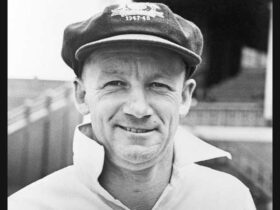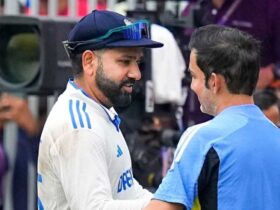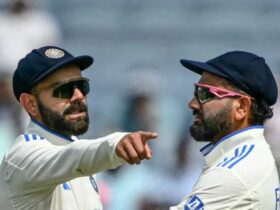India need 195 more runs to avoid the follow-on with six wickets in hand
India 51 for 4 (Rahul 33*, Starc 2-25) trail Australia 445 (Head 152, Smith 101, Carey 70, Bumrah 6-76) by 394 runs
Only 33.1 overs were possible on what may have been the stop-startiest day in the history of Test cricket, featuring as many as eight stoppages for rain, but Australia kept alive their hopes of going 2-1 up with two days remaining at the Gabba. They stretched their first-innings total to 445 on the morning of day three before Mitchell Starc, Josh Hazlewood and Pat Cummins ripped out India’s top order over the remainder of the day’s play, in between the many rain breaks.
India went to stumps at 51 for 4, 394 runs adrift of Australia, and their first target when the Test match resumes will be to get to 246 to avoid the follow-on. If they get there, they dramatically improve their chances of getting to Melbourne with the series still level. Rain is expected on days four and five as well, so Australia may be battling time if they’re forced to bat again.
Australia’s last three wickets added 40 runs to their overnight 405 for 7. There were brief spells of rain either side of the 17.1 overs they took to do so as well as one in between, after Jasprit Bumrah removed Pat Cummins to pick up his sixth wicket of the innings and his 50th in Tests in Australia. Alex Carey, who had raced to 45 on the evening of day two to keep Australia’s advantage intact after a three-wicket burst from Bumrah, brought up his half-century and played some resplendent strokes – including an effortless six over wide long-off off Akash Deep – before he was last out for 70. He was out to Akash Deep, who finally got a wicket with the 53rd false shot he had induced in the innings.
Australia’s fast bowlers then began to show how much more they could get out of this Gabba surface than India’s quicks had managed, thanks to both home and height advantage, with all three of Starc, Hazlewood and Cummins measuring upwards of 6’5″. They often found seam movement when they hit the pitch on a length or back of it, and occasionally awkward bounce too, with Hazlewood striking KL Rahul’s wrist with his first ball of the match.
By then, India were already one down, with Yashasvi Jaiswal having fallen second ball, flicking Starc uppishly and straight to Mitchell Marsh at square leg. Starc struck once more in his second over, slanting a full one away from Shubman Gill and inducing a drive away from the body with his head not on top of the ball. The ball flew quickly to the left of gully, and Marsh was once again in position to intercept it, this time with a spectacular dive to his left.
As much as the ball was doing off the deck, both of India’s wickets had fallen to avoidable shots, and the trend continued when Kohli – who, in the previous over, had to react quickly to fend away a Starc lifter that leapt towards his head – drove loosely at a wide one from Hazlewood and edged behind, falling early once again in series marked by uncertainty outside off stump.
Rain returned immediately after Kohli’s dismissal, prompting lunch to be taken early, and there was another interruption 11 balls after resumption. None of this was helping Australia’s victory push, but it was also keeping their fast bowlers fresh. It also meant India’s batters had to get their eye in multiple times.
All this, and superb bowling, contributed to India’s next wicket, with Cummins slanting one across Rishabh Pant from over the wicket and landing it on the perfect line and length to draw an uncertain forward-defensive push. Australia have noted Pant’s tendency to aim down the ground while defending balls angled across him, rather than going with the angle and playing later and squarer on the off side. This particular ball threatened to swing back into Pant before nipping away off the pitch, and found his edge through to Carey.
All through this, Rahul had batted with something approaching certainty, showing excellent judgment in the fourth-stump channel as well as a readiness – both in terms of intent and the timing of his weight transfer – to drive balls pitched up to him. Apart from o











Leave a Reply